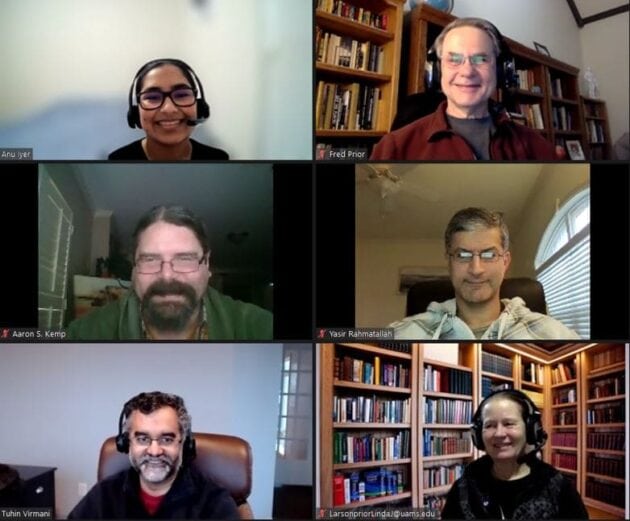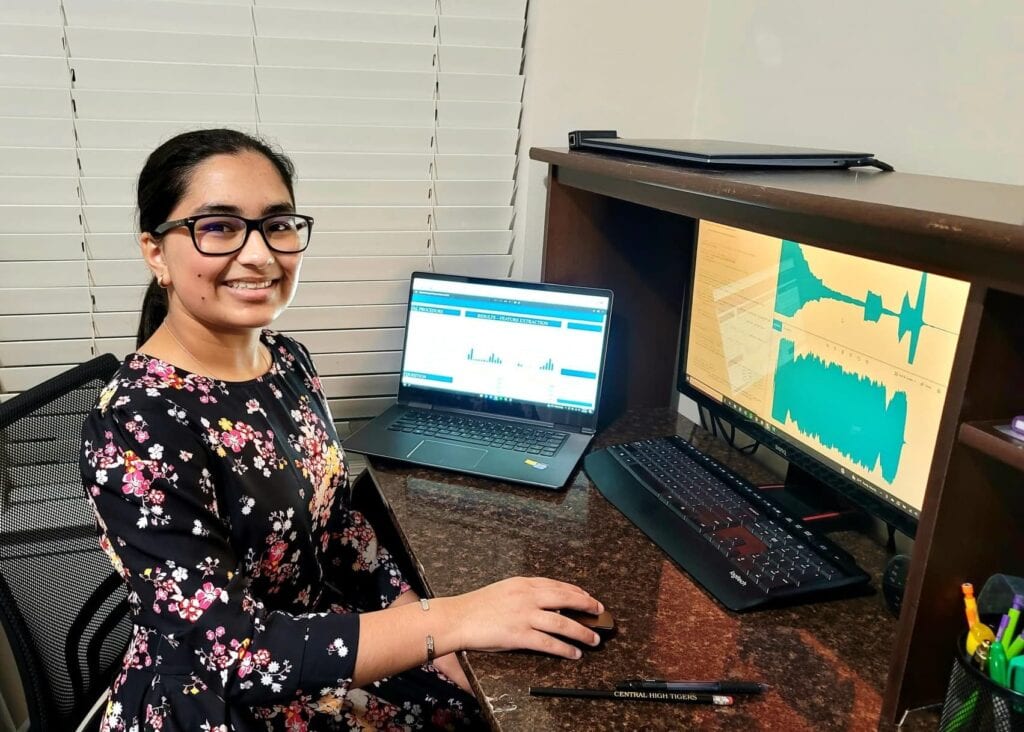When a UAMS Parkinson’s disease research project needed someone with machine learning expertise, Fred Prior, Ph.D., asked Anu Iyer if she would be interested.
It would have been a routine invitation among researchers at the University of Arkansas for Medical Sciences (UAMS), but Iyer is a junior at Little Rock’s Central High School. Prior, Iyer’s mentor on a previous project, said her award-winning computer and research skills put her well ahead of her peers.
“Anu is one of the best programmers I’ve met in a while,” said the professor and chair of the College of Medicine Department of Biomedical Informatics. “She’s very quick, very accurate, and her code is beautiful. I’m working with her like I would a graduate student, and that’s pretty amazing for someone in high school.”
The UAMS research team meets via Zoom every Saturday morning to help accommodate Iyer’s schedule. Top row: Iyer and Fred Prior, Ph.D.; middle: Aaron Kemp and Yasir Rahmatallah, Ph.D.; and bottom row: Tuhin Virmani, M.D., Ph.D., and Linda Larson-Prior, Ph.D.

Iyer’s addition to the team is among several unique features of the Parkinson’s disease pilot study. The team is testing innovative ways to monitor rural patients remotely, improve clinical outcomes and help patients participate in cutting-edge research without driving to UAMS in Little Rock. It is also building biomedical informatics tools that can organize the digital research data in a searchable format and will support future research projects.
The UAMS Translational Research Institute funded the study, which is led by movement disorders neurologist Tuhin Virmani, M.D., Ph.D., who directs the UAMS Movement Disorders Clinic and the Huntington’s Disease Society of America Center of Excellence at UAMS.
Virmani’s UAMS research partners also include the Rural Research Network, Regional Campuses and the Institute for Digital Health and Innovation.
Opportunity Knocks
His team is using the latest digital health technology to measure cognition, voice recordings and writing samples. The project is an extension of an in-person gait analysis project that requires use of a special sensor mat at Virmani’s clinic. The team is trying to develop ways to perform objective measures of disease progression, such as in gait, while continuing to respect current COVID-19 safety measures. The group found an alternative in speech analysis, which created the opportunity for Iyer.
“We found in the literature that we could get similar information on disease symptoms with voice recordings,” Prior said. “I knew Anu was looking for another project, and this is a great fit for her skill set.”
Iyer was excited to take on the challenge. “I’ll be training my computer model on all of the voice files to detect Parkinson’s disease in future patients and also determine which features in an audio file are more important for detecting Parkinson’s,” she said.
Machine learning involves creating computer systems that can learn and adapt by using algorithms and statistical models to analyze data and provide helpful information based on patterns in the data.
Virmani said Iyer has been a great addition to the team.
“I’ve been impressed with how she’s able to synthesize difficult concepts and actually take it to the next level,” he said. “That’s something that a lot of people are not able to do, even at the PhD level.”
Iyer has had a passion for science since early childhood and discovered the joy of computer programming in middle school. As a sixth grader, she led a team of classmates that won Best in State in the Verizon Innovative App Challenge. Her app measures the amount of ambient noise around a smart phone and adjusts the ring volume accordingly. The app award came with a $5,000 prize for her school, Forest Heights STEM Academy, and was featured in local media. The following year she became the lead programmer for her school’s robotics team.
Prior worked with Iyer as she interned at UAMS with support from a $3,360 National Science Foundation (NSF) grant to develop a more accurate machine learning tool for diagnosing multiple cancers by analyzing MRIs and pathology images. Her approach increased accuracy of diagnoses from less than 90% to nearly 96%. The work was published in November 2021 in the national Journal of Student Research.
The work also earned a second place in the inaugural Winthrop P. Rockefeller Cancer Institute Special Award for Outstanding Cancer Research at the Arkansas State Science and Engineering Fair.
The year before, in ninth grade, Iyer collaborated with UAMS’ Sami Uwaydat, M.D., professor, and Eugenia White, M.D., resident, in the College of Medicine Department of Ophthalmology. That project involved the creation of a machine learning tool to detect eye conditions such as diabetic macular edema and macular degeneration.
Her work has earned her top regional and state science awards and qualified for the International Science and Engineering Fair (ISEF).
Iyer said she is inspired by machine learning’s ability to provide dynamic solutions to complex problems.
“What fascinates me is how machine learning models can be trained on large sets of data with continuous feedback on training and accuracy,” she said.
Virmani’s research team meets via Zoom every Saturday morning to accommodate Iyer’s school schedule.“Meeting with them virtually, especially on weekends, has really helped me a lot, and I’m really grateful for the time that they’ve given to me,” she said.
The experience is helping her meet her academic goals and to decide on a career path.
After she creates a machine learning model that can detect Parkinson’s from audio files, she wants to do more extensive research on the disease’s causes and effects, and to improve diagnostic accuracy.
“Longer term, I plan on working in the medical field at the intersection of computer science and biometrics,” she said. “So I’m not exactly sure where I’ll be, but this research is helping me discover my interests.”

